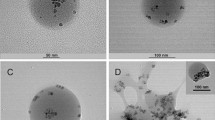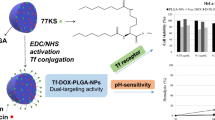Abstract
The aim of present study is to conceive a biodegradable poly(ethylene glycol)–polylactide (PEG–PLA) copolymer nanoparticle which can be surface biofunctionalized with ligands via biotin–avidin interactions and used as a potential drug delivery carrier targeting to brain glioma in vivo. For this aim, a new method was employed to synthesize biotinylated PEG–PLA copolymers, i.e., esterification of PEG with biotinyl chloride followed by copolymerization of hetero-biotinylated PEG with lactide. PEG–PLA nanoparticles bearing biotin groups on surface were prepared by nanoprecipitation technique and the functional protein transferrin (Tf) were coupled to the nanoparticles by taking advantage of the strong biotin–avidin complex formation. The flow cytometer measurement demonstrated the targeting ability of the nanoparticles to tumor cells in vitro, and the fluorescence microscopy observation of brain sections from C6 glioma tumor-bearing rat model gave the intuitive proof that Tf functionalized PEG–PLA nanoparticles could penetrate into tumor in vivo.









Similar content being viewed by others
Abbreviations
- PEG:
-
Poly(ethylene glycol)
- PLA:
-
Polylactide
- Tf:
-
Transferrin
- BBB:
-
Blood–brain barrier
- TfR:
-
Transferrin receptor
- DMEM:
-
Dulbecco’s modified Eagle’s medium
- FBS:
-
Fetal bovine serum
- GPC:
-
Gel permeation chromatography
- DLS:
-
Dynamic light scattering
- DiI:
-
1,1′-Dioctadecyl-3,3,3′,3′-tetramethylindocarbocyanine perchlorate
- FCS:
-
Fetal calf serum
References
Pardridge WM. Brain drug targeting: the future of brain drug development. Cambridge University Press, Cambridge; 2001.
Pardridge WM. BBB-Genomics: creating new openings for brain-drug targeting. Drug Discov. 2001;6:381–3.
Sinkula AA, Yalkowsky SH. Rationale for design of biologically reversible drug derivatives: prodrugs. J Pharm Sci. 1975;64:181–210.
Smith JJ. The world of science. Am J Sci. 1999;36:234–5.
Kreuter J. Application of nanoparticles for the delivery of drugs to the brain. Int Congr Ser. 2005;1277:85–94.
Calvo P, Gouritin B, Chacun H, Desmaële D, D’Angelo J, Noel JP, Georgin D, Fattal E, Andreux JP, Couvreur P. Long-circulating PEGylated polycyanoacrylate nanoparticles as new drug carrier for brain delivery. Pharm Res. 2001;18:1157–66.
Tsutsui Y, Tomizawa K, Nagita M, Michiue H, Nishiki T, Ohmori I, Seno M, Matsui HJ. Development of bionanocapsules targeting brain tumors. Control Release. 2007;122:159–64.
Daniels TR, Delgado T, Helguera G, Penichet ML. The transferrin receptor part II: targeted delivery of therapeutic agents into cancer cells. Clin Immunol. 2006;121:159–76.
Jefferies WA, Brandon MR, Hunt SV, Williams AF, Gatter KC, Mason DY. Transferrin receptor on endothelium of brain capillaries. Nature. 1984;312:162–3.
Hall WA. Transferrin receptor on glioblastoma multiforme. J Neurosurg. 1991;74:313–4.
Pardridge WM, Eisenberg J, Yang J. Human blood-brain barrier transferrin receptor. Metabolism. 1987;36:892–5.
Fishman JB, Rubin JB, Handrahan JV, Connor JR, Fine RE. Receptor-mediated transcytosis of transferrin across the blood-brain barrier. J Neurosci Res. 1987;18:299–304.
Descamps L, Dehouck MP, Torpier G, Cecchelli R. Receptor-mediated transcytosis of transferrin through blood-brain barrier endothelial cells. Am J Physiol. 1996;270:1149–58.
Hatakeyama H, Akita H, Maruyama K, Suhara T, Harashima H. Factors governing the in vivo tissue uptake of transferrin-coupled polyethylene glycol liposomes in vivo. Int J Pharm. 2004;281:25–33.
Kulkarni RK, Moore EG, Hegyeli AF. Biodegradable poly(lactic acid) polymers. J Biomed Mater Res. 1971;5:169–81.
Leenslag JW, Pennings AJ. Synthesis and morphology of high molecular weight poly (L-lactide), with tin 2-ethylhexanoate. J Makromol Chem. 1987;188:1809–16.
Sheikh FA, Barakat NAM, Kanjwal MA, Aryal S, Khil MS, Kim HY. Novel self-assembled amphiphilic poly(epsilon-caprolactone) -grafted-poly (vinyl alcohol) nanoparticles: hydrophobic and hydrophilic drugs carrier nanoparticles. J Mater Sci Mater Med. 2009;20:821–31.
Zhang J, Chen XG, Liu CS, Park HJ. Investigation of polymer amphiphilic nanoparticles as antitumor drug carrier. J Mater Sci Mater Med. 2009;20:991–9.
Olivier JC. Drug transport to brain with targeted nanoparticles. NeuroRx. 2005;2:108–19.
Béduneau A, Saulnier P, Benoit JP. Active targeting of brain tumors using nanocarriers. Biomaterials. 2007;28:4947–67.
Gref R, Couvreur P, Barratt G, Mysiakine E. Surface-engineered nanoparticles for multiple ligand coupling. Biomaterials. 2003;24:4529–37.
Roberts MJ, Bentley MD, Harris JM. Chemistry for peptide and protein PEGylation. Adv Drug Deliv Rev. 2002;54:459–76.
Scott MC, Robert FP, Robert L, Rick AR, Fiona EB, Martyn CD, Saul JBT, Kevin MS. A novel biotinylated degradable polymer for cell-interactive applications. Biotechnol Bioeng. 1997;58:529–35.
Salem AK, Cannizzaro SM, Davies MC, Tendler SJ, Roberts CJ, Williams PM, Shakesheff KM. Synthesis and characterisation of a degradable poly(lactic acid)-poly(ethylene glycol) copolymer with biotinylated end groups. Biomacromolecules. 2001;2:575–80.
Seth AT, Gilad DE, Frank XG, Martin PS, Robert HB Jr, Robert SL. Tetanus toxin C fragment-conjugated nanoparticles for targeted drug delivery to neurons. Biomaterials. 2007;28:5176–84.
Murakami H, Kobayashi M, Takeuchi H, Kawashima Y. Further application of a modified spontaneous emulsification solvent diffusion method to various types of PLGA and PLA polymers for preparation of nanoparticles. Powder Technol. 2000;107:137–43.
Ma WJ, Yuan XB, Kang CS, Su T, Yuan XY, Pu PY, Sheng J. Evaluation of blood circulation of polysaccharide surface-decorated PLA nanoparticles. Carbohydr Polym. 2008;72:75–81.
Gref R, Luck M, Quellec P, Marchand M, Dellacherie E, Harnish S, Blunk T, Muller RH. ‘Stealth’ corona-core nanoparticles surface modified by polyethylene glycol (PEG): influences of the corona (PEG chain length and surface density) and of the core composition on phagocytic uptake and plasma protein adsorption. Colloids Surf B Biointerfaces. 2000;18:301–13.
Jeong JH, Kim BY, Lee SJ, Kim JD. A novel immobilization technique using a poly(aminoacid) multilayer designed for surface plasmon resonance sensing. Chem Phys Lett. 2006;42:373–7.
Eavarone DA, Yu X, Bellamkonda RV. Targeted drug delivery to C6 glioma by transferrin-coupled liposomes. J Biomed Mater Res. 2000;51:10–4.
Soni V, Kohli DV, Jain SK. Transferrin coupled liposomes as drug delivery carriers for brain targeting of 5-florouracil. J Drug Target. 2005;13:245–50.
Zhong W, Parkinson JA, Guo M, Sadler PJ. Unusual features for zirconium(IV) binding to human serum transferrin. J Biol Inorg Chem. 2002;7:589–99.
Davies M, Parry JE, Sutcliffe RG. Examination of different preparations of human placental plasma membrane for the binding of insulin transferrin and immunoglobulins. J Reprod Fertil. 1981;63:315–24.
Enns CA, Suomalainen HA, Gebhardt JE, Schröder J, Sussman HH. Human transferrin receptor: expression of the receptor is assigned to chromosome 3. Proc Natl Acad Sci USA. 1982;79:3241–5.
Ambruosi A, Khalansky AS, Yamamoto H, Gelperina SE, Begley DJ, Kreuter J. Biodistribution of polysorbate 80-coated doxorubicin-loaded [C-14]-poly(butyl cyanoacrylate) nanoparticles after intravenous administration to glioblastoma-bearing rats. J Drug Target. 2006;14:97–105.
Brigger I, Morizet J, Aubert G, Chacun H, Terrier-Lacombe MJ, Couvreur P, Vassal G. Poly(ethylene glycol)-coated hexadecylcyanoacrylate nanospheres display a combined effect for brain tumor targeting. J Pharmacol Exp Ther. 2002;303:928–36.
Acknowledgments
This work was financially supported by China National Natural Scientific Found (50573056), Tianjin Science and Technology Committee (06YFGZSH00800).
Author information
Authors and Affiliations
Corresponding authors
Electronic supplementary material
Below is the link to the electronic supplementary material.
Rights and permissions
About this article
Cite this article
Ren, Wh., Chang, J., Yan, Ch. et al. Development of transferrin functionalized poly(ethylene glycol)/poly(lactic acid) amphiphilic block copolymeric micelles as a potential delivery system targeting brain glioma. J Mater Sci: Mater Med 21, 2673–2681 (2010). https://doi.org/10.1007/s10856-010-4106-5
Received:
Accepted:
Published:
Issue Date:
DOI: https://doi.org/10.1007/s10856-010-4106-5




